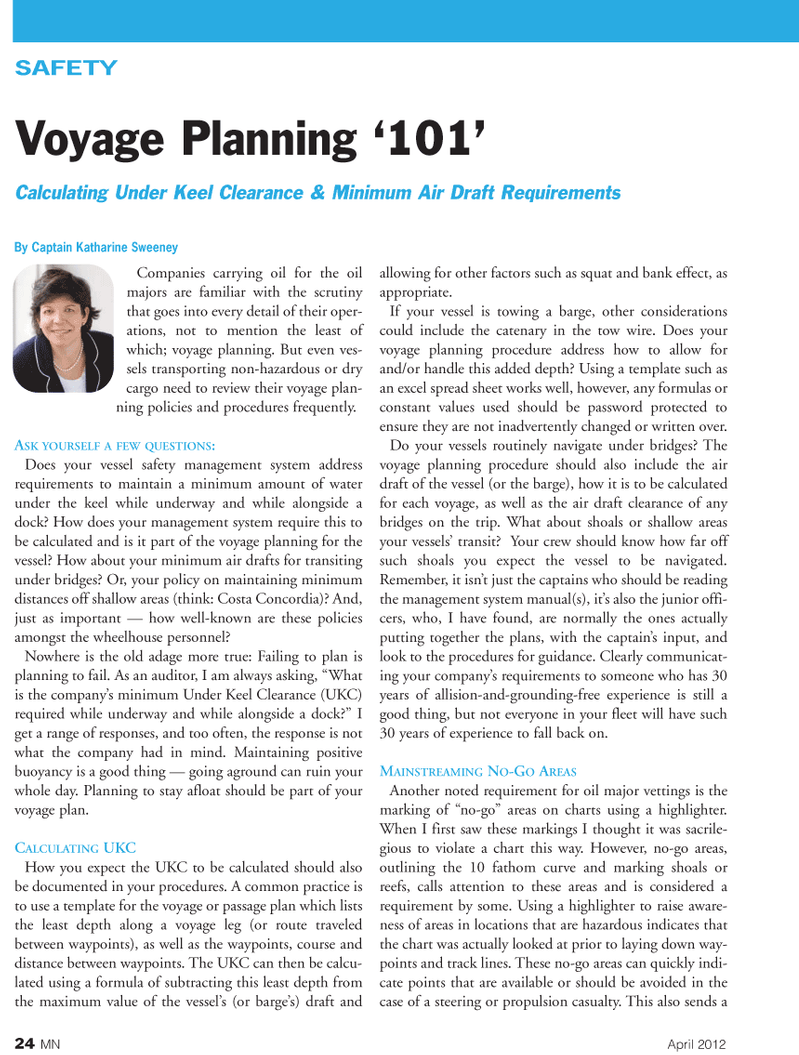
Page 24: of Marine News Magazine (April 2012)
Offshore Service Operators
Read this page in Pdf, Flash or Html5 edition of April 2012 Marine News Magazine
24MNApril 2012Companies carrying oil for the oil majors are familiar with the scrutiny that goes into every detail of their oper- ations, not to mention the least ofwhich; voyage planning. But even ves- sels transporting non-hazardous or dry cargo need to review their voyage plan- ning policies and procedures frequently. ASKYOURSELFAFEWQUESTIONS :Does your vessel safety management system address requirements to maintain a minimum amount of water under the keel while underway and while alongside a dock? How does your management system require this to be calculated and is it part of the voyage planning for the vessel? How about your minimum air drafts for transiting under bridges? Or, your policy on maintaining minimum distances off shallow areas (think: Costa Concordia)? And, just as important ? how well-known are these policies amongst the wheelhouse personnel?Nowhere is the old adage more true: Failing to plan is planning to fail. As an auditor, I am always asking, What is the companys minimum Under Keel Clearance (UKC) required while underway and while alongside a dock?? I get a range of responses, and too often, the response is not what the company had in mind. Maintaining positive buoyancy is a good thing ? going aground can ruin your whole day. Planning to stay afloat should be part of your voyage plan. CALCULATING UKC How you expect the UKC to be calculated should also be documented in your procedures. A common practice is to use a template for the voyage or passage plan which lists the least depth along a voyage leg (or route traveled between waypoints), as well as the waypoints, course and distance between waypoints. The UKC can then be calcu- lated using a formula of subtracting this least depth from the maximum value of the vessels (or barges) draft and allowing for other factors such as squat and bank effect, as appropriate. If your vessel is towing a barge, other considerations could include the catenary in the tow wire. Does your voyage planning procedure address how to allow for and/or handle this added depth? Using a template such as an excel spread sheet works well, however, any formulas or constant values used should be password protected to ensure they are not inadvertently changed or written over. Do your vessels routinely navigate under bridges? The voyage planning procedure should also include the air draft of the vessel (or the barge), how it is to be calculated for each voyage, as well as the air draft clearance of any bridges on the trip. What about shoals or shallow areas your vessels transit? Your crew should know how far off such shoals you expect the vessel to be navigated. Remember, it isnt just the captains who should be reading the management system manual(s), its also the junior offi- cers, who, I have found, are normally the ones actually putting together the plans, with the captains input, and look to the procedures for guidance. Clearly communicat- ing your companys requirements to someone who has 30 years of allision-and-grounding-free experience is still a good thing, but not everyone in your fleet will have such 30 years of experience to fall back on. MAINSTREAMINGNO-GOAREASAnother noted requirement for oil major vettings is the marking of no-go? areas on charts using a highlighter. When I first saw these markings I thought it was sacrile- gious to violate a chart this way. However, no-go areas, outlining the 10 fathom curve and marking shoals or reefs, calls attention to these areas and is considered a requirement by some. Using a highlighter to raise aware- ness of areas in locations that are hazardous indicates that the chart was actually looked at prior to laying down way- points and track lines. These no-go areas can quickly indi- cate points that are available or should be avoided in the case of a steering or propulsion casualty. This also sends a SAFETYBy Captain Katharine SweeneyVoyage Planning 101 Calculating Under Keel Clearance & Minimum Air Draft Requirements

 23
23

 25
25
